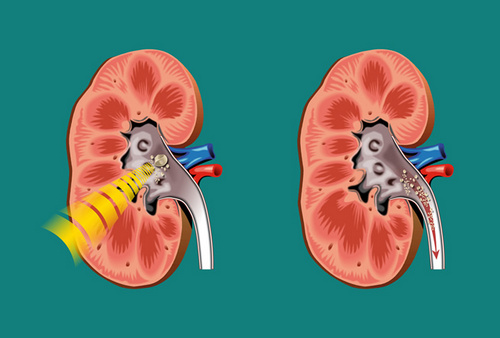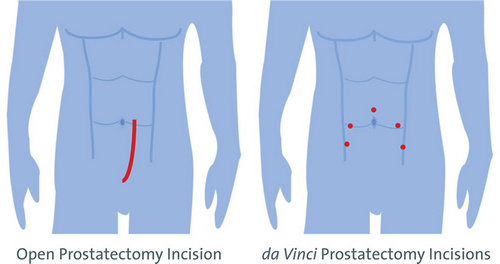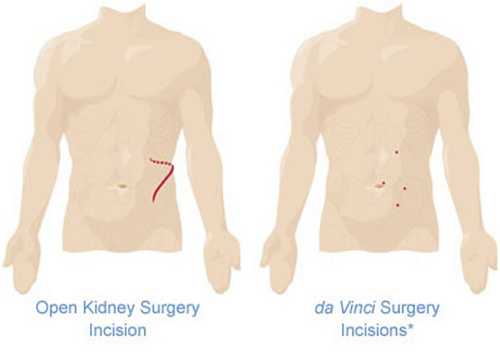ESWL: Extracorporeal Shock Wave Lithotripsy®
Extracorporeal Shock Wave Lithotripsy (ESWL) is the most common treatment for kidney stones in the United States. Shock waves from outside the body are targeted at a kidney stone causing the stone to fragment.
The stones are broken into tiny pieces that can then pass safely on their own. This procedure is non-invasive and usually done under mild sedation rather than general anesthesia.
These are what the words mean:
- extracorporeal: from outside the body
- shock waves: pressure waves
- lithotripsy (the Greek roots of this word are “litho” meaning stone, “tripsy” meaning crushed)
Ureteroscopy
This involves the passage of a small instrument through the urinary tract and up to stone in the kidney or ureter. This is one of the most common way that stones are treated and does carry a very high success rate. Compared to ESWL, this often requires the placement of a stent in the ureter to allow for healing, which can be associated with increased discomfort. This is usually does as an outpatient procedure and does require general anesthesia.

PCNL (Percutaneous Nephrolithotomy)
This is the preferred treatment for larger stones and is done through a small, keyhole opening in the flank. This allows the surgeon to pass a special instrument directly into the kidney to remove the stone(s). Larger stones may need to be broken up using a special instrument called an ultrasonic lithotriptor Cyberwand®.
The stone can then be extracted through the same incision. Although this approach typically requires a hospital stay and is more invasive than ureteroscopy or ESWL, it is often the most effective method for treating large stones quickly and completely.
da Vinci Robotic Surgery
Some of the urologic procedures that can be performed through robotic-assisted techniques include:
- Prostatectomy – A prostatectomy is the surgical removal of the prostate gland, commonly used to treat prostate cancer. A traditional open prostatectomy can include an incision up to ten inches long and a high risk of incontinence and erectile dysfunction while laparoscopic techniques offer less accuracy and rigid movement.
da Vinci® Surgery
With the da Vinci System, surgeons operate through a few small incisions instead of a large open incision – similar to traditional laparoscopy. The da Vinci System features a magnified 3D high-definition vision system and special wristed instruments that bend and rotate far greater than the human wrist. da Vincienables your doctor to operate with enhanced vision, precision, dexterity and control. Click here to learn more about da Vinci Prostatectomy

- Cystectomy – A cystectomy is the removal of part or all of the bladder and may be performed to treat bladder cancer. As an open or laparoscopic procedure, a cystectomy comes with high risks, large scars and limited control.
da Vinci® Surgery
With the da Vinci System, surgeons make just a few small incisions instead of a large open incision – similar to traditional laparoscopy. The da Vinci System features a magnified 3D high-definition vision system and special wristed instruments that bend and rotate far greater than the human wrist. As a result, da Vinci enables your doctor to operate with enhanced vision, precision, dexterity and control. Click here to learn more about da Vinci Cystectomy
- Kidney surgery – Kidney surgery may be used to remove cancerous tumors or correct obstructions. Open or laparoscopic techniques for this procedure require a large incision or result in limited movement and dexterity for the doctor.

da Vinci® Surgery
With the da Vinci System, surgeons make just a few small incisions instead of a large open incision – similar to traditional laparoscopy. The da Vinci System features a magnified 3D high-definition vision system and special wristed instruments that bend and rotate far greater than the human wrist. As a result, da Vinci enables your doctor to operate with enhanced vision, precision, dexterity and control. Click here to learn more about da Vinci Nephrectomy




I have to to learn more insight from you! Of course I’ll share this post right now. TY!
Nice post. I learn something more challenging on different blogs everyday. It will always be stimulating to read content from other writers and practice a little something from their store. I?d prefer to use some with the content on my blog whether you don?t mind. Natually I?ll give you a link on your web blog. Thanks for sharing.
yahoo took me here. Cheers!